MIYAJIMA ISLAND (宮島) - HIROSHIMA
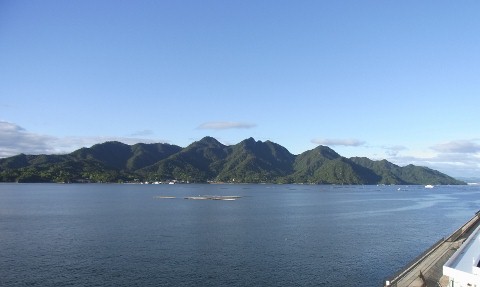 |
At high tide, Itsukushima shrine and the huge torii look like floating on the sea and the vermilion shrine is reflected on the sea with the beautiful Mt. Misen primeval forest; it stands in perfect harmony with its natural surroundings.
In fact, the shrine and the torii are not anchored to the ground and stand by themselves without requiring any other means of support.
You will be surprised at the work with the great knowledge and the Japanese old style technique that can neither make the torii washed away by the sea nor fall down and that can neither make the shrine float nor washed away.
Miyajima island has much more to offer, such as the Omotesando shopping street, Gojunoto (Five-Storied Pagoda), Senjokaku (Hall of One Thousand Tatami Mats) (Toyokuni Shrine), Daiganji Temple, Daishoin Temple, Tahoto, Momijidani Park, Aquarium, and some other temples and shrines, you name it.
Miyajima holds several unique and historical festivals and events all the year round.
The popular and famous feature of the festivals is Miyajima-on-the-sea-Fireworks Display which beautifully reflects on the sea on the backdrop of the Itsukushima shrine and torii.
| Main Sights in Miyajima | ||
| Itsukushima Shrine | ||
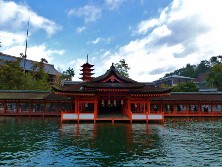 Itsukushima Shrine is the main attraction in Miyajima. Itsukushima Shrine is the main attraction in Miyajima.It is believed that the shrine was constructed by Kuramoto Saeki in 593. From ancient times, people have sensed the spiritual sanctity of Miyajima, and have revered and worshipped the island itself as goddesses. Therefor, people avoided building shrines on such a sacred place and the shrine was built in the sea. During the era of Taira-no-Kiyomori, it became a place of worship for the Heike clan, and around 1168, the main shrine building was constructed. As the power of the Heike clan increased, the number of worshippers at the shrine increased, the shrine itself began to become known among the members of the Imperial Court, and its grandeur became more and more magnificent. The emperor and the Imperial Court paid visits to the shrine, and the culture of the Heian Period was amiably incorporated. Bugaku, ancient Japanese musical court dance, also began during this period. Even after the fall of the Heike clan, the culture of the Heian Period was warmly accepted by the Genji clan and the shrine continued to experience a stable and prosperous era. The shrine was battered by the sea breezes and typhoons sometimes and was rebuilt, but we are fortunately able to see the same shrine as Taira-no Kiyomori did. |
||
| O-Torii Gate (Grand Gate) | Senjokaku (Toyokuni-jinja) | Gojuno-to (Five Storied Pagoda) |
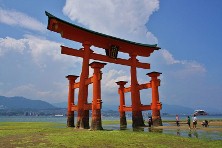 The vermilion O-torii is about 16.6 meters in as the same height as Daibutsu's in Nara (Big Buddha) and weighs about 60 tons. The main pillars are made of natural 500-600 year-old camphor trees. When the present O-torii, which is the eighth since the Heian Period, was erected, it is said that it had taken nearly 20 years to find such giant trees. It is not anchored to the ground and stands under its own weight. |
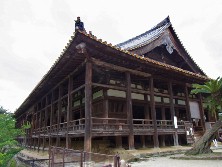 Hideyoshi Toyotomi started to build Senjokaku for the repose of the war dead in 1587. However, the construction was suspended midway due to Hideyoshi's death, the structure still remains unfinished today. In Edo period, Senjokaku was familiar to the people as a forum, and for that, names of kabuki troupes and Senryu which is short and witty Japanese poem are written on its big pillars. |
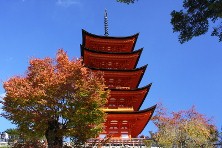 The beautiful vermilion five storied pagoda is standing next to Senjokaku. |
| Daishoin Temple | Daiganji Temple | Mt. Misen |
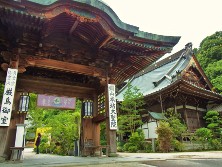 Daishoin Temple is an ancient Shingon Buddhist temple built at the foot of the sacred Mt. Misen. Its green, plant-filled precincts command a fine view and are decorated with many Buddhist statues. Daishoin Travel Guide |
 The founder of this temple is not known though, Priest Ryokai and Priest Enkai are known to have contributed to prosperity of the temple. Daiganji Temple is dedicated to Benzaiten, the Goddess of eloquence, music, wisdom and wealth, and is known as one of the three most famous Benzaiten Temples. |
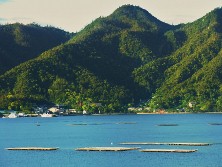 Covered with virgin forests, where conifers coexist with southern plants, Mt. Misen, the highest mountain on Miyajima Island rises 535 meters above sea level. The mountain enchants visitors with the beauty of its natural forests inhabited by different varieties of plants and fine views which can be enjoyed from the mountain top. Mt. Misen Travel Guide |
| Momijidani Park | Tahoto Pagoda (Two-storied Pagoda) | Kiyomori-jinja Shrine |
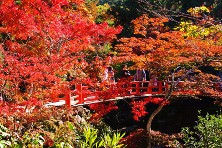 Momijidani Park is a quiet park stretching along the valley at the foot of Mt. Misen, and also along the Momijidani River. Visitors can enjoy how each season brings its own seasonal beauty to the park; cherry blossoms in spring, the magnificent sight of lush greenery. Particulary in autumn, the park presents a splendid view with its wide variety of scarlet-tinged maple leaves. The leaves begins to change color from around November 10th and its best time is around the 20th of November every year. |
This pagoda with a height of 15.6m is said to have been built in 1523 and stands on the west side of the hill from the Itsukushima shrine. The area around the pagoda is famous for the beauty of its cherry blossoms in the spring and when the Itsukushima shrine is lighted up, it becomes a beautiful backdrop.
|
Around March 20th, the anniversary of Kiyomori's death, the Kiyomori Festival is held.
|
| Other Sights in Miyajima | ||
| Treasure Hall | Museum of Historical and Folklore Materials | Miyajima Traditional Crafts Center |
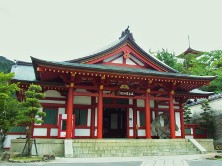 Housed herein are some 3.500 valuable items – industrial art works, armory, household effects, Noh masks, musical instruments etc., mostly used by the top figures of the Heike Clan, a dominant politico-military family in the feudal days. Many of them are valuable and rare, and are designated as national treasures. |
The museum exhibits folk materials that provide insights into the lives of ordinary people, and historical materials including ancient documents, and poems and paintings depicting Miyajima. |
This is the place where you can learn the history and traditions of Miyajima through hands-on experiences. |
| Miyajima Aquarium | Omoto Park | Illuminated Itsukushima Shrine |
|
It is currently closed for renovation and will reopen in August 2011. |
After you walk deeper from Miyajima Aquarium and see a quiet park, called Omoto Park, where there is a Omoto shrine at the entrance of it. It is also famous for the beauty of its cherry blossoms in the spring. |
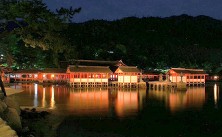 lighting-up is performed around Itsukushima Shrine from 30 minutes after sunset to 11:00 p.m. every day and you can enjoy another fantastic world of Miyajima |
| Omotesando Shopping Arcade | O-syamoji | |
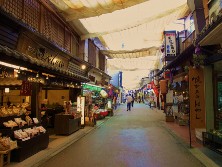 |
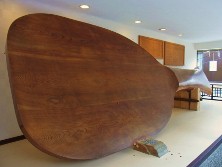 |
|
| Other Temples and Shrines in Miyajima | ||
| Omoto Shrine | Awashima Shrine | Sannou Shrine |
|
It is unknown when it was established, but it's older than the Itsukushima shrine.
The festival "Momotesai" is held here on January 20. |
The annual celebration is held on May 3.
|
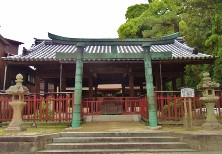 The annual festival is held on October 23 and the court dance and music are performed. |
| Saiwai Shrine | Komyoin Temple | Hojyuin Temple |
| The annual celebration is held on August 15 (on the lunar calendar). |
It is believed that Ihachi founded in Muromachi Period.
|
It is believed that it was founded in 946 and famous for a lucky charm to increase one's business.
|
| Tokujyuin Temple | Shinko-ji Temple | Zonko-ji Temple |
|
It is believed those who pray for the Kosazuke-Jizo at the temple will be blessed with children.
|
This is only one Jyodo-Shinshu Temple on Miyajima.
|
Sotoshu Temple. It is professed as Visually-impaired people's pray are answered
|
| Tips | ||
| Sign for Ropeway | ||
 |
||
How to travel on Miyajima Island
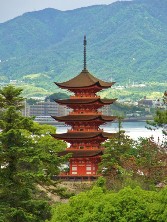 Two ferry companies operate between Miyajimaguchi and Miyajima island;
the JR ferry and the Miyajima Matsudai Kisen.
Two ferry companies operate between Miyajimaguchi and Miyajima island;
the JR ferry and the Miyajima Matsudai Kisen.You don't need to wait for a long time as they run about every 15 minutes. Taking the JR ferry to Miyajima Island should be better, because only the JR ferry will get closer to the Torii before it gets to the pier. It might be the only way to see the Torii on the backdrop of the shrine from the sea, unless you charter a boat or take a cruising boat. Don't miss the perfect shot! Keep the right side of the deck in the direction of forward movement about 5 minutes after its departure since it takes about 10 minutes to get to the island.
On your way back, it should be a good idea to take a ferry leaving earlier as both come straight back to Miyajimaguchi.
Japan Rail Pass covers only the JR ferry. 2 one-way trip tickets and 1 round trip ticket for the both companies cost the same.
Itsukushima Shrine is a MUST-SEE on a Miyajima sightseeing trip, but what you must not miss more is to see the shrine and the Torii seemingly floating in the sea during high tide. Make sure to check the time of high tide beforehand. Keep it in your mind that it might be too late about one hour before/after the time of high tide. You should be there about 30 minutes before/after the time of it.
Go to "Time of high tide", and check the time of high tide.
If you can't manage to get there on the time of high tide, you will achieve different benefits.
You can walk to touch the Torii directly and see that the shrine is just put on the ground without any supports, you have to see the shrine and the torii on the mad, though.
What is more, lighting-up is performed around Itsukushima Shrine from 30 minutes after sunset to 11:00 p.m. every day and you can enjoy another fantastic world of Miyajima. It should be more perfect when it's high tide at night.
Note that almost all the shops and restaurants on the island after 5 pm to 6 pm are closed.
.jpg) Don't forget to get a free map at the information centers at the either
side of the piers. English and some other language versions are available.
Don't forget to get a free map at the information centers at the either
side of the piers. English and some other language versions are available.Deer will welcome you just after you arrive, but it wouldn't be the best time to play with them while holding the map you've just got. They will eat your map! It would be worse if you are showing them bank bills and your tickets.
Explore Miyajima in time for high tide.
It is also recommended to climb up to the top of Mt. Misen that has a panoramic view of many islands in the Seto inland sea. There are a variety of routes to the summit. It's possible to climb up through the Momijidani Park and take another route leading back down to Disyoin Temple and vice verse.
The descent takes about an hour. Sometimes you see signs saying, "- minutes, if you walk. -minutes, if run.” It's possible to take the two-stage ropeway, or a cable car from around the back of the Momijidani Park, but it leaves you about 20-30 minute walk from the top.
Further details about Mt. Misen...
In autumn, the maple leaf which is a symbol of Hiroshima prefecture turns a deep red color, and add an extra touch to the Momiji-dani Park (Maple Valley Park) .
It should be a good idea to soak in an onsen (hot spring) at a spa or an onsen of a hotel where only taking a bath is available after climbing up the mountain in Miyajima to make you refreshed.
Fill your stomach with grilled oysters (only winter) that are sold around the shopping street, Momiji-manju (sweet-bean buns which are shaped like a maple leaf) which is famous as a souvenir from Miyajima and Anago-meshi which is broiled conger eel on top of rice. It is basically hard to find a good and inexpensive restaurants as most of them are for tourists on the island. It might be most enjoyable and good to have what they sell at open-air shops here and there.
Oysters are famous local products of Hiroshima and the season is only winter. Anago-meshi is a famous local product of the place around Miyajima. Try freshly-baked Momiji-manju in Miyajima!! You have to mention that; "Yakitate no Momiji-manju kudasai. (Please give me a freshly baked Momiji-manju)."
It is recommended to go to Miyajima on weekdays so you can enjoy the quiet and fine atmosphere, instead of going there on weekends or national holidays when it’s really crowded.
It takes about a whole day to explore most of the attractions in Miyajima.
However, to walk around the back streets behind the touristic main street will show you the real beauty and goodness of Miyajima.
Why don't you walk around the streets where the old tastes of Japan like in Kyoto still remains while overlooking the islands in the Seto inland sea and being surrounded by the primeval forest?
Miyajima should be a must-see unless you like Japanese old style-like things or deer on the island.
History
It should be difficult to know all the Japanese history only for a couple of weeks while traveling in Japan, but if you know, your adventure in Japan will be more and more interesting through what you see from the lives of historical characters.Picking up interesting times roughly, they should be End of Heian Period, the age of provincial wars and End of Edo Period.
In the each period, the political powers changed and Japan was in turbulent times.
Here, Itsukushima shrine is deeply linking to the end of Heian Period.
If the End of Heian Period can be summed up, it should be "the Buddhist concept of the impermanence of worldly things" like it brings everything to nothing with heroism of a "do-or-die" nature.
The warrior (Bushi) class gained power in the twelfth century.
A war between the Taira clan (Heike) and the Minamoto clan (Genji) broke out and the Taira clan won. In the result, the Taira family gained power and the time of Taira-no Kiyomori who was the leader of the clan came.
In the world those days, the people called them "the high-blown Heike (the Taira family)". It is said that Taira-no Kiyomori put a lot of his own money into the renovations of this Itsukushima shrine and it is Heike's (the Taira family's) guardian god. The great flamboyance of the vermilion shrine and torii mirror how much they flourished.
Before long, Taira-no Kiyomori passed away from febrile illness and the time of his children came.
Meanwhile, the leader of the Minamoto clan, Minamoto-no Yoritomo rose up in arms in Izu (near Kamakura in Kanagawa prefecture) with those who waited for a chance to revenge while living underground and rose in rebellion against the Taira clan.
Minamoto-no Yoshitsune who was a tragic hero and a strategy genius started chasing the Taira clan from Kansai area in the Seto Inland Sea and destroyed the peace-addicted Taira clan at Dan-no-ura in the end.
While the Taira clan were fighting, but in reality running away, they stopped over at the Itsukushima shrine to pray for victory along the way.
The sight of the Taira clan's fall is just like all the petals of cherry blossoms fall to the ground beautifully.
Events and Festivals in Miyajima
Miyajima Oysters Festival- In the second weekend in February Oysters, Miyajima's specialty, are served at low prices.
Date ⁄ Time February 13(Sat) and 14(Sun), 2010
10:00 - 15:00
Location ・ In front of the Miyajima pier.
・ In front of the Miyajima Aquarium.
Miyajima Hina Doll Festival
- See the antique dolls on display at over 30 locations throughout Miyajima.
Date March 25 - April 3 Main displays ・ Miyajima History and Folklore Museum
(English speaking guides)
・ Daishoin Temple
・ Nosaka House
・ Yoshida House
・ Konishi House Official Ticket Please buy a ticket at the Miyajima pier for the five main displays
Adult : 300yen ⁄ Age 15-18 : 170yen ⁄ Age 6-14 : 150yen
Kiyomori Festival
- In remembrance of the reverential virtue of Kiyomori Taira who built the foundation of the prosperity of Miyajima, the Kiyomori festival in the motif of "Itsukushima Shrine prayer parade of the Heike family" is held in March.
Date ⁄ time from 1:00 to 3:00 p.m., Monday, March 22, 2010
Place Square in front of Miyajima pier → Omotesando Shopping Arcade → Mikasahama beach → Itsukushima Shrine → Kiyomori Shrine
* Participants pass through from Miyajima pier via Itsukushima Shrine worship to Kiyomori Shrine on parade in disguise such as the Heian picture scroll.
Toka Festival and Kikka Festival
- The court dance and music introduced into Miyajima from Kyoto by Kiyomori Taira is dancing by the gagaku.
Toka Festival (Peach Blossom Festival)
- Date From about 18:00 on April 15
Program Enbu, Manzairaku, Engiraku, Tourika, Ikkyoku, Soriko, Sanju Kitoku, Ryohoh, Nasori, Chohgeishi
Kikka Festival (Chrysanthemum Festival)
- Date From about 18:00 October 15
Program Enbu, Manzairaku, Engiraku, Gaden, Ikkyoku, Soriko, Sanju, Kitoku, Ryohoh, Nasori, Chohgeishi
Shin noh Festival
- Shin noh (noh play) in the Toka Festival was assumed to be held for three days from the 16th.
Noh is a lyric dance-drama and performed on a special stage to the accompaniment of music.
Date From April 16 to 18 every year Location Itsukushima Shrine (Noh Stage) Contents
16th, the opening day
・・・ Kita school
17th, the second day
・・・ Kanze school
18th, the third day
・・・ Kita school
Okina is played at the beginning of the opening day and the third day, and the five pieces of noh play are performed for these three days.
Other schools might sometimes perform them.
Hiwatarishiki in Daisho-in Temple
- It takes place twice a year on April and November 15th. While mountain priests blow their conch shells the arrangement of cypress branches is ignited.
After the fire burns down and only red coals remain, the head Buddhist monk, followed by the mountain monks and worshippers, walk barefoot across the coals chanting a prayer for good health and fortune.
Date ⁄ Time April and November 15th 11:00 -
Location Daishoin Temple
Participation Fee Free
Kangen Festival (Annual Music Festival on Boats)
This event is the largest annual festival observed at Itsukushima Shrine, and takes place on the night of June 17th of the lunar calender.
Date July 28th, 2010 (Wed)
※June 17th by the lunar calendar Location Itsukushima Shrine
Miyajima Water Fireworks Display

- Over 300,000 visitors enjoy the fireworks show every year. The scene with the Ororii Gate silhouetted by the illumination of the fireworks attracts thousands of photo enthusiasts.
Miyajima-on-the-Sea Fireworks Display is one of the most famous in Japan.
- Date/ August 14, 2010 (Sat) 19:50 - 20:50
Location/ off shore from the Otorii Gate
Information / Miyajima Tourist Association
TEL : 0829-44-2011
Chinka-sai Festival
- Over 300,000 visitors enjoy the fireworks show every year. The scene with the Ororii Gate silhouetted by the illumination of the fireworks attracts thousands of photo enthusiasts.
The Chinka-sai, Fire Prevention Festival
- The Chinka-sai, Fire Prevention Festival, takes place on the last day of
the year in front of Itsukushima Shrine.
Date December 31st, 18:00
Location Itsukushima Shrine, Miyajima
Food in Miyajima
MomijimanjuMomijimanju, sweet-bean buns shaped like a maple leaf, is the most popular sweet on Miyajima. You can enjoy freshly-baked Momijimanju on Miyajima. You have to mention that; "Yakitate no Momiji-manju kudasai. (Please give me a freshly baked Momiji-manju)."
Enjoy Momijimanju with a free cup of tea which are prepared for customers!
Age-Momiji
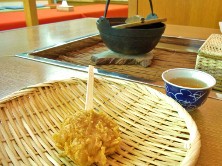
Anago
Anago in Miyajima are conger eels caught in the Seto Inland Sea.
Anago-meshi is a dish with broiled conger eel on top of rice.
Anago-meshi is a famous local product of the place around Miyajima.
.jpg) Oysters
OystersOysters are famous local products of Hiroshima and the season is only winter.
Oysters look grotesque, but they are really good, especially it's grilled on a grid with shells.
Suvenir in Miyajima
Syamoji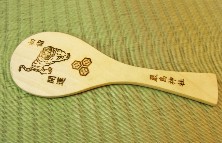
Restaurant in Miyajima
Hiramatsu-jyaya
Time and Fee
Itsukushima ShrineOpen hours
1 ⁄ 1 - 5 ⁄ 1: Not fixed
6 ⁄ 1 - 28 ⁄ 2: 6:30 - 17:30
1 ⁄ 3 - 14 ⁄ 10: 6:30 - 18:00
15 ⁄ 10 - 30 ⁄ 11: 6:30 - 17:30
1 ⁄ 12 - 31 ⁄ 12: 6:30 - 17:00
Admission fee: Adult ¥300; High school student ¥200; School child ¥100; Under 6 Free
Treasure Hall
Open hours: 8:00 - 17:00; Open throughout the year
Admission fee: Adult ¥300; High school student ¥200; School child ¥100; Under 6 Free
Senjokaku
Admission fee: Adult ¥100; Child (6 - 15) ¥50 ; Under 6 Free
Common admission ticket for Itsukushima Shrine & Treasure Hall
Admission fee: Adult ¥500; High school student ¥300; School child ¥150; Under 6 Free
Traditional Crafts Center
Open hours: 9:00 - 17:00; Close on Tuesdays -- * Wednesday, if Tuesday is a holiday.
Admission fee: Free
Historical and Folklore Materials House
Open hours: 8:30 - 17:00 (Close on Mondays)
Admission fee Regular Group (15 -); Adult ¥300 ¥210; High school student ¥170 ¥120; School child ¥150 ¥100; Under 6 Free
Miyajima Aquarium ※Closed for renovation.
Access to Miyajima
To MiyajimaguchiBy JR line
About 25 minutes from JR Hiroshima Station by the Sanyo Main Line to Miyajimaguchi Station.
*From Hiroshima Station, many express trains bound for Iwakuni operate.
By Streetcar
By Hiroshima Electric Railway (Hiroden), about 60 minutes from Hiroshima Station to Hiroden Miyajimaguchi Station.
*It's recommended to enjoy the view from the window on the way and it's possible to get to Miyajimaguchi from the center of Hiroshima city by streetcar directly, but it takes a long time. If you don't have enough time, it's better to take a streetcar from the center of Hiroshima station and get off at Nishi-Hiroshima station (about 20 minutes) and take JR line to Miyajimaguchi. It takes about 10 minutes from JR Nishi-Hiroshima station to JR Miyajimaguchi station.
* To the ferry pier, it's right in front of Hiroden Miyajimaguchi station (streetcar) and 1-2 minute straight walk from JR Miyajimaguchi station.
By boat
About 22 minutes from Hiroshima Port (Ujina Port) to Miyajima Pier by high-speed boat.
About 50 minutes from the Peace Memorial Park Motoyasubashi Pier to Miyajima Pier by high-speed boat.
By bus
Almost no bus to Miyajimaguchi directly. It's better to use a streetcar or a train.
By car
About 3 km (10 min.) from Ohno IC and Hatsukaichi IC via Route 2
By air
From Hiroshima Airport
Travelling from Hiroshima Station takes 48minutes by shuttle bus. Take the Sanyo line from JR Hiroshima Station to JR Miyajimaguchi.
From Hiroshima West Airport
Travelling from Hiroshima West Airport to Nishi Hiroshima station take around 19 minutes by taxi. Take the Sanyo line from JR Nishi Hiroshima Station to JR Miyajimaguchi.
By ferry
About 10 minutes by ferry from Miyajimaguchi to Miyajima. (JR and Miyajima Matsudai Tourist Ship operate between Miyajimaguchi and Miyajima Pier. The ferry runs about every 15 minutes. One-way trip costs 170 yen for adults and 80 yen for children)
JR ferry Tel(0829)56-2045
Matsudai Tourist Ship Tel(0829)44-2171
Transportation in Miyajima
Rental CycleBusiness hours: 8:00 - 17:00
Fee (Normal bicycle): 2 hours ¥320; Extra 1 hours ¥110; One day ¥1,050
Taxi Rates
Business hours: 7:30 - 19:00
Fee (From the Pier): To Aquarium ¥710 - ¥870; To Ropeway ¥710; To Tsutsumigaura ¥870
Miyajima Ropeway
The ropeway allows all visitors to enjoy climbing Mt. Misen. From the carrier you are able to enjoy a beautiful view of the Seto Inland Sea and virgin forests.Note that it will leave you about 20-30 minute walk from the top.
Ropeway Fares Round trip 1,800 yen (Child 900 yen)
Operating hours 9:00 - 17:00
*Business hours are different according to the season.
Contact Momijidani park, Miyajima-cho, Hatsukaichi-shi, Hiroshima-ken 739-0522
TEL 0829-44-0880
Miyajima Ropeway (Cable car)
Open hours: Jan. Feb. Dec. 9:00 - 16:30; Mar. Apr. Jun. Jul. Sep. Oct. 9:00 - 17:00; May(G.W) Aug.(Obon) 8:30 - 17:00; Nov. 8:00 - 17:00
Fee: Adult ¥1,800 (Return), ¥1,000 (One way); Child (6 - 12) ¥900 (Return), ¥500 (One way); Under 6 Free
Free Shuttle Bus for Momijidani Ropeway Station
Free shuttle buses from Momiji-dani Koen Iriguchi (紅葉谷公園入口: Momiji-dani Park Entrance in fromt of Ryokan Iwaso) to Momijidani Ropeway station run every 20 minutes.
Where do you want to go in Chugoku?
How to get to and around Hiroshima
From Kansai international airportShinkansen route
Japan Railways
Highway bus route
Streetcar in Hiroshima
Buses in Chugoku
Related Pages
What you need in Japan and before/after in Japan
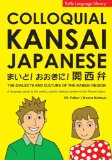 |
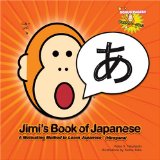 |
 |
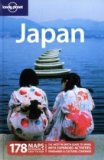 |
 |
 |
Find more...